.
MesoAmerican Art
|
The colossal stone heads found at Olmec sites
in southern Veracruz and Tabasco are the oldest known monuments in
Prehispanic Mexico. No one knows for certain whether they are portrayals
of their rulers or gods, or why they were dragged over 60 miles to
the Gulf coast of Mexico- where they were unearthed centuries later.
Their Asiatic features adds some validity to the idea that the ancient
Americans may have originally descended from Asians who crossed the
Bering Strait thousands of years ago.
Olmec culture is the foundation
of all subsequent civilizations of Mesoamerica. Influence of its religion,
symbolic language, and architectural layouts are evident in later
civilizations such as the Teotihuacan, Mayan, Toltec and Aztec cultures.
|
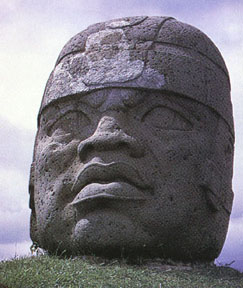
Olmec Head,8' tall, 1500-300 B.C.E. |
|
Teotihuacan
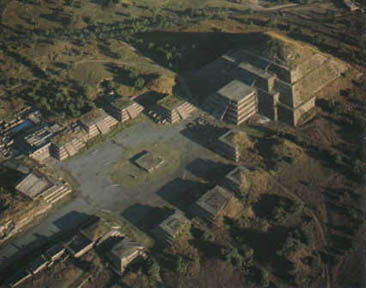
The Pyramid of the Sun, Teotihuacan (360 - 650 C.E.)
|
The largest and oldest pyramids
in the Americas are those at Teotihuacan, the "City of the Gods".
The building of the Pyramid of the Sun and the Pyramid of the Moon coincides
with the period of Roman Empire. They are joined by a long path called
the "Avenue of the Dead", where later Mexicans believe that
the Teotihuacanos buried their kings. Of the two pyramids, the Pyramid
of the Sun is the tallest (over 200 feet), and was built over a natural
cave. It is possible that the ancient culture believed that their ancestors
emerged from this cave.
Fifteen smaller pyramids are
arranged symmetrically around the walls of the immense quadrangle. Another
structure outside of this quadrangle was built later, during the classic
period. It is known as the Feathered Serpent Pyramid.
|
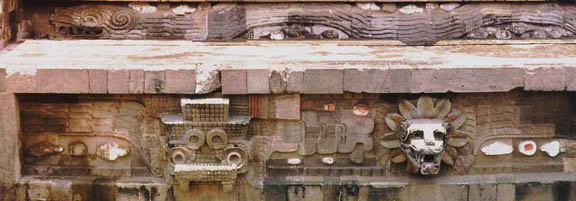
Carved details on the Pyramid of the Feathered Serpent, Teotihuacan
| The Pyramid of the Feathered
Serpent derives its name from the sculptures which cover the structure.
A feathered serpent carrying a headdress is surrounded by water imagery,
including white shells of many different species. There are 366 of these
heads, covering all 4 sides of the pyramid. It is possible that they
were related to the 366 days of their calendar. |
The
Mayans
|
The Mayans represent
the highest achievements of Precolumbian culture, and is the best-known
of the classical civilizations of Mesoamerica. Originating in the Yucatan
around 2600 B.C.E., the Mayans rose to prominence around 250 C.E. in
present-day southern Mexico, Guatemala, northern Belize and western
Honduras.
Known for their
intelligence, they excelled especially in the areas of architecture,
sculpture, painting, mathematics, and astronomy. While Europe was still
in the Dark Ages, the Mayans had the most accurate calendar in the world.
Their writing was based on a hieroglyphic system, but most of their
codexes have been lost to the later invasions of the Spanish. The few
that survive have allowed archeologists to learn about their rituals
and beliefs.
|
|
|
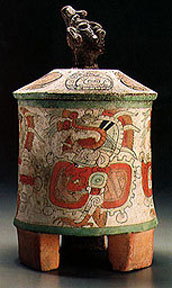
Cylindrical Tripod Vase with Effigy Cover
Guatemala, Central Lowlands, Maya, 300-400
|
|
The art of the Maya is principally the art of the ruling elite.
Vessels were made to honor and commemorate once living rulers
and to venerate their gods and ancestors.These objects are full
of symbolism regarding the afterlife. Much of the pottery found
in Maya tombs were made especially to accompany the soul on its
journey through the underworld.
The Vase at left depicts the "Pauahtuns", the directional
world-bearers who steadied the earth above the Maya underworld.
It may have contained ashes, or possibly food for the deceased.
The face of a king is incised on the surface of the conch shell
trumpet, at right. An inscription names its owner, and the portrait
on the shell is thought to be the ancestor who was summoned when
the trumpet was used in a bloodletting rite.
|
|
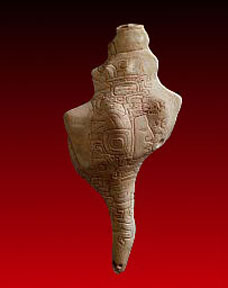
Incised Conch Shell Trumpet
Guatemala, Maya, about 250-400
|
Mayan
Architecture:
Deep within the jungles of Mexico
and Guatemala and extending into the Yucatan peninsula lie the mysterious
temples and pyramids of the Maya. Without metal tools, beasts of burden or
even the wheel they were able to construct vast cities across a huge jungle
landscape with an amazing degree of architectural perfection and variety.
|
Palenque
Located in Chiapas,
Mexico, Palenque is one of the Maya civilization's greatest
ruins. Although the earliest occupation of the site dates to
about 100 BC, it becomes a major population center only at about
600 C.E. and all construction at the site has ceased by about
800 C.E. The Palenque Palace was constructed over a period of
several hundred years by several rulers,and is richly decorated
with delicately sculpted scenes depicting rituals, ceremonies
and deities. It was the residence of the king, and also a place
for worship. The building's platform supports 15 structures
dedicated to different ritual ceremonies. Located underneath
the south end of the Palace are several subterranean chambers
that indicate earlier occupation of the Palace.
|
|

Palenque Palace (foreground) and Temple of Inscriptions
|
|
|
Inside the
Temple of Inscriptions is the tomb of the most famous Palenque ruler:
Pacal, who assumed power in 603 C.E. at the age of 12 and ruled for
68 years until his death in 683. His tomb contains a sarcophagus which
is covered by a richly-sculpted slab of white limestone.
Weighing five tons, this slab depicts the story of death and rebirth
of the ruler. It depicts Pacal falling into jaws of the terrestrial
monster (death) on his way to the Underworld (rebirth). The sides of
the sarchophagus depict Pacal's ruling ancestors.
|
|
|
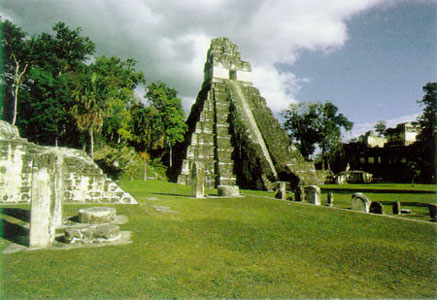
Temple of the Giant Jaguar, 870 C.E.
|
Tikal
Tikal was a primary city
of the Maya. At least 10,000 people lived within the city, which covers
six square miles. Their maps reveal 3000 separate constructions, including
temples, palaces, shrines, residences, ballcourts, terraces, and plazas.
The heart of Tikal was the Great Plaza, which is surrounded by the two
largest temples, and to the north is a cluster of temples known as the
North Acropolis. Especially notable within this cluster is the Temple
of the Giant Jaguar, named after a motif on one of its lintels. It towers
145 feet, and tombs are beneath and inside the structure. In addition
to the buildings and monuments, 100,000 tools, ceremonial objects and
personal ornaments have been unearthed in Tikal.
|
|
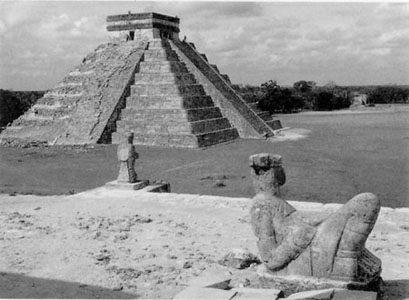
Castillo, with Chacmool Yucatan, Mayan, 9th-13th century
|
Chichen
Itza
One of the greatest of the
Mayan sites and the most fully restored is the huge site of Chichen Itza.
Many structures here relate to the Mayan's intense interest in astronomy.
South of the Castillo is a strange round building known as the Carocal,
which was probably used as an observatory. Several of its windows point
towards the equinox sunset and the southernmost and northernmost points
on the horizon where Venus rises.
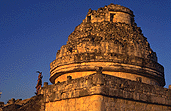
The Observatory at Chichen Itza
|
|
| "The Nunnery" at Chichen
Itza was given its name because of its resemblance to convents in Spain.
They were probably the living quarters of the elite Mayans. Located in the
southern group of ruins, it contains some of the best preserved structures
at Chichen Itza. Every square foot of wall has reliefs and paintings decorating
it. |
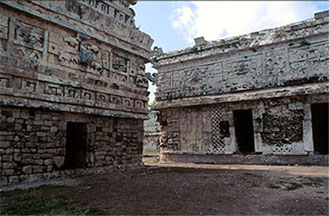 |
Next: Prehistoric Art
|